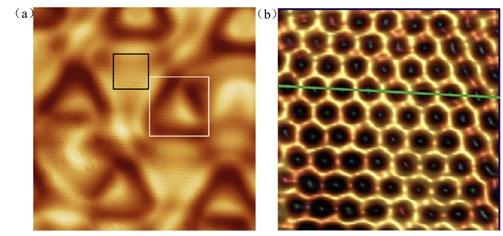
Boron Breakthrough: Pure Honeycomb Borophene Structure Revealed

High resolution STM images of borophene monolayer with honeycomb lattice on Al(1 1 1).
Credit: ©Science China Press
An intriguing question is whether it is possible to prepare a borophene monolayer with a pure honeycomb lattice. Honeycomb borophene will naturally host Dirac fermions and thus intriguing electronic properties resembling other group IV elemental 2D materials.
Additionally, a honeycomb 2D boron lattice may enable the superconductivity behavior. Since in the well-known high Tc superconductor, MgB2, the crystal structure consists of boron planes with intercalated Mg layers, where the boron plane has a pure honeycomb structure like graphene. It is remarkable that in MgB2, superconductivity occurs in the boron planes, while the Mg atoms serves as electron donors.
Recently, the research team led by Prof. Wu reported the successful preparation of a purely honeycomb, graphene-like borophene, by using an Al(1 1 1) surface as the substrate and molecular beam epitaxy (MBE) growth in ultrahigh vacuum. Scanning tunneling microscopy (STM) images reveal perfect monolayer borophene with planar, non-buckled honeycomb lattice similar as graphene.
Theoretical calculations show that the honeycomb borophene on Al(1 1 1) is energetically stable. Remarkably, nearly one electron charge is transferred to each boron atom from the Al(1 1 1) substrate and stabilizes the honeycomb borophene structure.
This work vividly demonstrated that one can manipulate the borophene lattice by controlling the charge transfer between the substrate and the borophene. And the honeycomb borophene provides attractive possibility to construct boron-based atomic layers with unique electronic properties such as Dirac states, as well as to control superconductivity in boron-based compounds.
###
This work was supported by the National Key Research and Development Program (2016YFA0300904 and 2016YFA0202301), the National Natural Science Foundation of China (11334011, 11674366 and 11674368), and the Strategic Priority Research Program of the Chinese Academy of Sciences (XDB07010200 and XDPB06).
See the article:
Wenbin Li, Longjuan Kong, Caiyun Chen, Jian Gou, Shaoxiang Sheng, Weifeng Zhang, Hui Li, Lan Chen, Peng Cheng, Kehui Wu, Experimental Realization of Honeycomb Borophene, Science Bulletin, 2018, Vol.63, No. 5: 282-286 https:/












